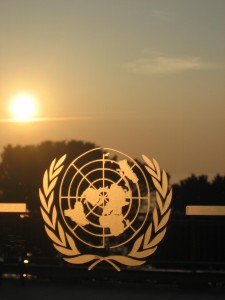During the annual European Meteorological Society’s (EMS) annual meeting in Berlin, I was pleasantly surprised by a magazine called ‘theWeather’, issued by the theWeather Club, an outreach activity associated with the Royal Meteorological Society. TheWeather Club was awarded the EMS outreach & Communication award 2011 for this magazine.
An exercise about meaningful numbers: examples from celestial “attribution studies”
Is the number 2.14159 (here rounded off to 5 decimal points) a fundamentally meaningful one? Add one, and you get
π = 3.14159 = 2.14159 + 1.
Of course, π is a fundamentally meaningful number, but you can split up this number in infinite ways, as in the example above, and most of the different terms have no fundamental meaning. They are just numbers.
But what does this have to do with climate? My interpretation of Daniel Bedford’s paper in Journal of Geography, is that such demonstrations may provide a useful teaching tool for climate science. He uses the phrase ‘agnotology’, which is “the study of how and why we do not know things”.
How large were the past changes in the sun?
We only have direct observations of total solar irradiance (TSI) since the beginning of the satellite era and substantial evidence for variations in the level of solar activity (from cosmogenic isotopes or sunspot records) in the past. Tying those factors together in order to estimate solar irradiance variations in the past is crucial for attributing past climate changes, particularly in the pre-industrial.
In the May issue of Astronomy & Astrophysics, Shapiro et al. present a new long-term reconstruction of the solar irradiance that implies much greater variation over the last 7000 years than any previously reconstruction. What is the basis for this difference?
[Read more…] about How large were the past changes in the sun?
An incremental step blown up
New results from the University of Aarhus in Denmark and the Danish National Space Institute allegedly show that particles from space create cloud cover, according to a recent press release. And the Physics World magazine (May, 2011) report that the
researchers say this is the best experimental evidence yet that the Sun influences the climate by altering the intensity of the cosmic-ray flux reaching the Earth’s surface.
Quite spectacular claims! So let’s see what is the source of this information.
The basis for the statements was a recent paper published in GRL by Enghoff et al. The key points in the paper are stated as: (a) Cosmic rays increase nucleation rate, (b) A particle beam is not needed, for experiments, and (c) Ions are important for atmospheric nucleation rate. But where is the link to real clouds?
Handbook in Denialism

Furthermore, denial is not the same as being skeptical, either, and Washington and Cook argue it is quite the opposite. Hence, the term “skeptics” for these deniers can be described as Orwellian “doublespeak”“newspeak”.
Denial is apparently caused by our lizard brainstem. What coincidence then, when talking about fossil fuels from plants from the era of huge long dead lizards (the fossil fuels are not made of the dinosaurs), that denying evidence for anthropogenic global warming (AGW) is linked to that lizard part of the brain. So, what about using the labels ‘reptiles’ or ‘dinos’? Washington and Cook opt for ‘deniers’, and so will I hereafter.
Making climate science more useful

The CORDEX initiative, as the abbreviation ‘COordinated Regional climate Downscaling Experiment‘ suggests, tries to bring together the community of regional climate modellers. At least, this initiative has got a blessing from the World Climate Research Programme WCRP.
I think the most important take-home message from the workshop is that the stake holders and end users of climate information should not look at just one simulation from global climate models, or just one downscaling method. This is very much in agreement with the recommendations from the IPCC Good Practice Guidance Paper. The main reason for this is the degree of uncertainties involved in regional climate modelling, as discussed in a previous post.
What we do not know in terms of adaptation
A recent paper by Oreskes et al. in the journal Philosophy of Science asserts that “there is a gap between the scale on which models produce consistent information and the scale on which humans act”. While the large scales, such as the global mean, provide the best indicators of the state of earth’s climate, it is on the local scales we feel a climate change, such as floods and extreme weather events. Extreme rainfall is usually local. So how is it possible then, as two new papers in Nature by Min et al. and Pall et al. (discussed here) have done, to attribute extreme precipitation and extreme UK floods to climate change?
[Read more…] about What we do not know in terms of adaptation
How easy it is to get fooled
When you analyse your data, you usually assume that you know what the data really represent. Or do you? This has been a question that over time has marred studies on solar activity and climate, and more recently cosmic rays and clouds. And yet again, this issue pops up in two recent papers; One by Feulner (‘The Smithsonian solar constant data revisited‘) and another by Legras et al. (‘A critical look at solar-climate relationships from long temperature series.’). Both these papers show how easily it is to be fooled by your data if you don’t know what they really represent.
The obvious answer
Climate science appears to be just like any other science. At least, this is the conclusion from a fresh publication by Marianne Ryghaug and Tomas Moe Skjølsvold (“The global warming of climate science: Climategate and the construction of scientific facts” in International studies in the philosophy of science). This finding is not news to the research community, but this analysis still hints that everything is not as it should be – because why would anyone report from a crime scene if the alleged crime has not even been committed?
Cold winter in a world of warming?

Last June, during the International Polar Year conference, James Overland suggested that there are more cold and snowy winters to come. He argued that the exceptionally cold snowy 2009-2010 winter in Europe had a connection with the loss of sea-ice in the Arctic. The cold winters were associated with a persistent ‘blocking event’, bringing in cold air over Europe from the north and the east.